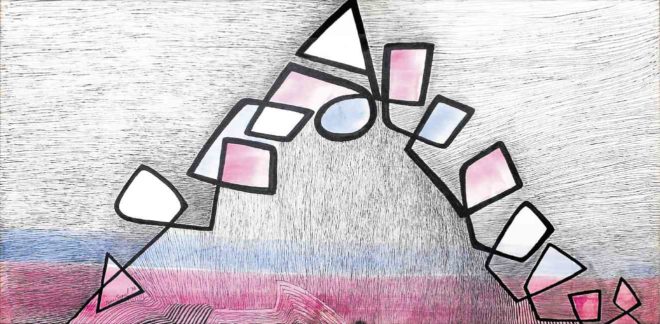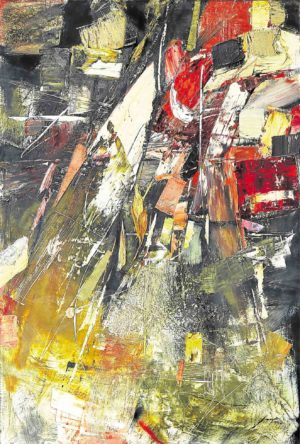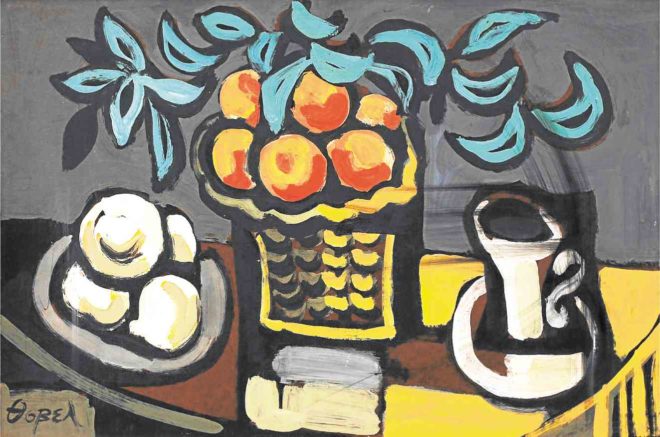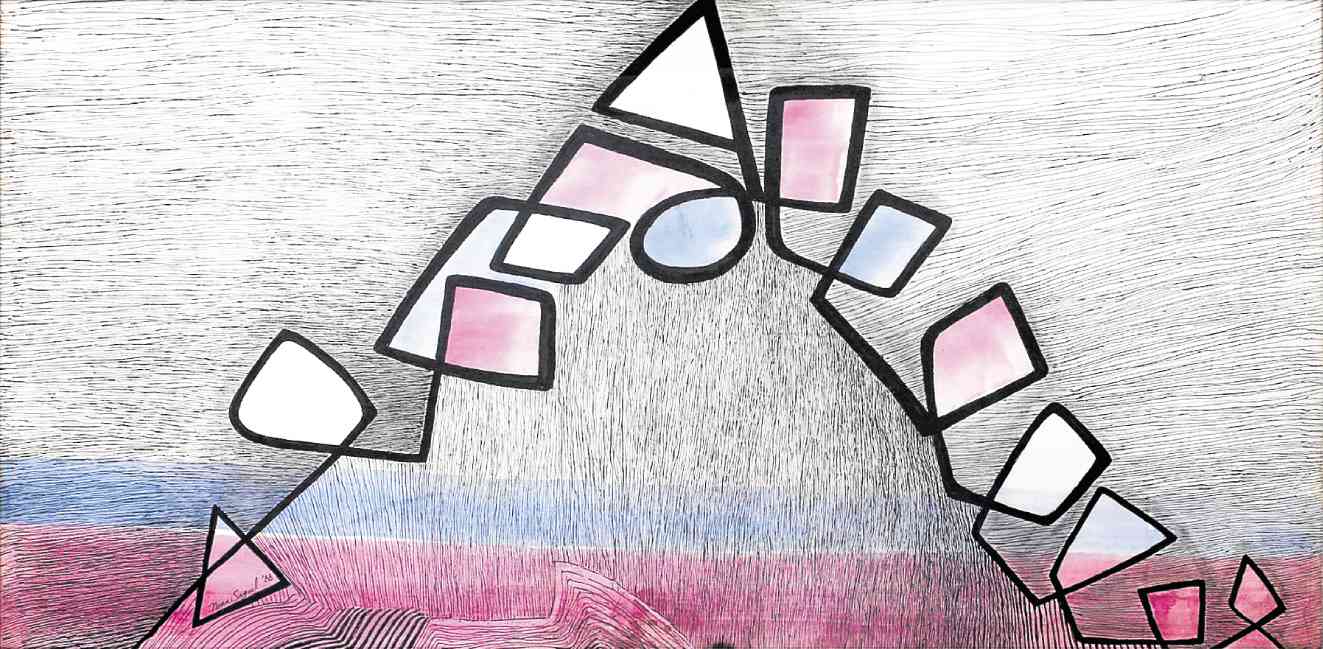

One of the nine paintings by Jóse Joya exhibited at the 32nd Venice Biennale in 1964 will be auctioned off by León Gallery during its Spectacular Midyear Auction on June 10.
A key work by Fernando Zóbel, who had exhibited at the Spanish Pavilion in Venice two years before, will also be auctioned off as part of what Léon owner, Jaime Ponce de Léon, called as “the most breathtaking selection of highly important works in a single sale to date.”
The work by Joya (1931-1995) is signed and dated 1962, and is intriguingly titled “Carcass.” Emmanuel Torres, who was with Joya in Vienna in 1964, wrote an essay about the experience and mentioned “Carcass” as part of the exhibit.
Only two other Joya works from Venice have been accounted for, and they provide a stark contrast to “Carcass”: “Granadean Arabesque” at the Ateneo Art Gallery, and “Hills of Nikko” at the National Gallery Singapore, on loan from the National Museum of the Philippines.
These two abstract landscapes are works that critic Emmanuel Torres may trace to Joya’s travels, and he even mentioned other apparent abstract landscape works by Joya in Venice such as “Venetian Daybreak” and “Episode
in Stockholm.”
In contrast, “Carcass,” by the title alone, seems drawn from a starker sensibility and experience.
But the work, characterized by heavy reds and browns, and bolder, frenetic, and even hysterical impasto strokes (what Torres described as “palette-knife fury”), seems to evoke a bull’s carcass after a matador’s fatal blow, and, like “Granadean Arabesque,” seems part of Joya’s Iberian experience when he got a grant from Instituto de Cultura Hispanica to travel in Spain in the 1950s.
Torres described Joya’s work in Venice: “All nine oil paintings are consistently high in quality; more than half of them are among the best Joya has ever painted to date and technically impressive by international standards, to my mind. They showed Venetian art cognoscenti the variety of content and the expressive range of Joya’s visual language.”
Joya’s paintings were complemented by Napoleon Abueva’s modernist wood sculptures in 1964, in what would be the first and last time for the Philippines to be in the oldest, biggest and most prestigious art fair in the world.
It would only be in 2015, after an absence of half a century, that the Philippines would return there.
In the context of what happened, Torres’ assessment of the Philippines’ showing in 1964 seemed a case of hoping against hope: “A small splash but a good start,” he declared of the country’s participation. “What matters is that, if a bigger splash is to follow the initial plunge, the time to prepare for it is NOW.”
Bidding opens at P8 million.
Key Zóbel works
Joya obtained his Spanish travel grant through the influence of Zóbel (1924-1984). Like the Philippines, Zóbel has returned to Venice this year with an exhibit solely devoted to his life and art mounted by the Ayala Museum at the Fondaco Marcello, running until Nov. 26.
Perhaps to complement Joya’s Venice work on auction, Zóbel’s contrasting works in representationalism and abstraction will be auctioned off.
His 1953 oil-on-wood, “Zurbarán SL-II,” is a tribute to the Spanish Baroque master (1598-1664) and the latter’s famous “Still Life with Lemons, Oranges and a Rose,” which is now in a private museum in Pasadena.
As Lisa Guerrero Nakpil, in her very informative notes in the auction catalogue writes: “SL” seems shorthand for “still life,” and the flora here represents allegories of the Blessed Mother and the spiritual life.
“Zóbel, on the other hand,” writes Nakpil, “decided to take apart this enigmatic work: Instead of the objects resting on a highly burnished table-top—which would capture their reflections—he chose to divide the field, paralleling what Zurbaran did, into three sections.
The basket of oranges is now mirrored by an amorphous slab of gray and ecru, as is the cup on the silver plate. The rose now melds into the reflection. In addition, Zóbel chose to color block the various areas, using a bright yellow in particular, to highlight the right side. He would use this technique in future works a decade later.”
Bidding begins at P2.4 million.
The other work to be auctioned off harks back to Zóbel’s 1962 Venice participation via the Spanish Pavilion—it is part of his “Saetas” series of works.
Ponce de Léon says the work is “circa 1957-1958,” and is one of Zóbel’s “earliest forays into abstract art; and one can completely sense the quivering motion of these lyrical arrows.”
The “Saetas” series was inspired by calligraphy, Japanese Zen and Mark Rothko.
The lines or arrows (saeta means “arrow”) were “movement expressed metaphorically through the use of line,” Zobel wrote. “The movement of leaves, blades of grass, trees, birds, people; movement observed, never imitated, but, I hope, translated.”

Nakpil writes: “In this untitled work, Zobel seems to capture an imaginary forest, the browns and greens approximating trees around patch of blue water. Crimson and white lines intersect in busy counterpoint.”
Bidding starts at P8 million.
Nena Saguil
Another Philippine artist whom Zóbel helped send to Spain was Nena Saguil, who is represented in the June auction at the Léon Gallery.
Saguil, Zóbel and Joya took part in what Torres called “the groundbreaking enterprise” of the first nonobjective art exhibit organized by the Philippine Art Gallery in 1953.
Saguil (1924-1994) studied in Madrid in the early 1950s and moved to Paris in 1956. When the Philippines participated in Venice, she was bruited about to be the next Philippine artist to be featured in the biennale.
To be auctioned off by Léon is an untitled work, signed and dated 1988, a watercolor and pen-and-ink on paper.
“It is in the style of what Torres would call the ‘Billboard Shorthand’ of her last decade,” writes Nakpil. “Torres even describes it as ‘A single coiled spring. A single spiraling ribbon
or confetti.’”
Adds Nakpil: “The work is covered with thousands of fine hairlines that rain on the painting, swerving into angles at the bottom. The colors mirror the ‘lyrical transformation’ that Torres noted happened in the late 1970s and mid-1980s—as Saguil moved from monochromes to ‘painting in prismatic colors,’ thus the pinks, blues and yellows of ‘a rich paster luster.’”
Bidding starts at P400,000.
Art lovers may also want to bid for Saguil’s early representational work, “Still Life,” signed and dated 1950, oil on canvas.
“Saguil eschews traditional composition,” Ramon Villegas notes in the auction catalogue. “Her flowers are strewn on a surface seemingly in disarray. She barely attempts to be botanically correct, but the blooms appear to include frangipani or plumeria, hibiscus, and lilies … This still-life is evidence of her efforts to break from the academic mold and that in her art she lay in the full embrace of modernism.”
Bidding starts at P1.8 million.
Ponce de Léon said the “museum-quality artworks” to be sold on June 10 have unimpeachable documentation and provenance.
Previews are on June 3 to 9, from 9 a.m. to 7 p.m. Auction is on June 10 at 2 p.m. at Leon Gallery, Eurovilla 1, Rufino and Legazpi Sts., Legazpi Village, Makati City. Visit
www.leon-gallery.com.









































